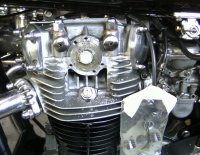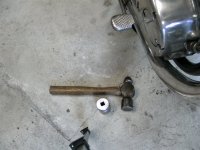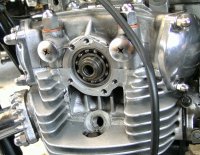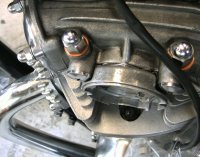This evening, village m/c engineer came and fitted five helicoils to the points housing:

Note cardboard 'wheel' and plenty of grease to catch the swarf?
Once I had cleaned 'er off, fitted Boyer rotor and static plate and went for a test run. Seemed to run a bit hot. Checked timing with strobe and too far advanced. Retarded it a bit and second test run. Probably ran better. Hard to say. Lots of popping and banging on the overrun. Carbs? Timing? Air leak in the exhaust?
And it blew the fuse for the starter circuit again. But enough for tonight.
At least it runs. Still holds back from closed throttle. But no oil leak from behind the points cover. AND at no point did the clutch let go.
So two-and-a-half cheers, I'd say.

Note cardboard 'wheel' and plenty of grease to catch the swarf?
Once I had cleaned 'er off, fitted Boyer rotor and static plate and went for a test run. Seemed to run a bit hot. Checked timing with strobe and too far advanced. Retarded it a bit and second test run. Probably ran better. Hard to say. Lots of popping and banging on the overrun. Carbs? Timing? Air leak in the exhaust?
And it blew the fuse for the starter circuit again. But enough for tonight.
At least it runs. Still holds back from closed throttle. But no oil leak from behind the points cover. AND at no point did the clutch let go.
So two-and-a-half cheers, I'd say.

 ) has pulled a lot of nasty tricks on me over the years, but she has never spilled a drop of engine oil from that area.
) has pulled a lot of nasty tricks on me over the years, but she has never spilled a drop of engine oil from that area. 


